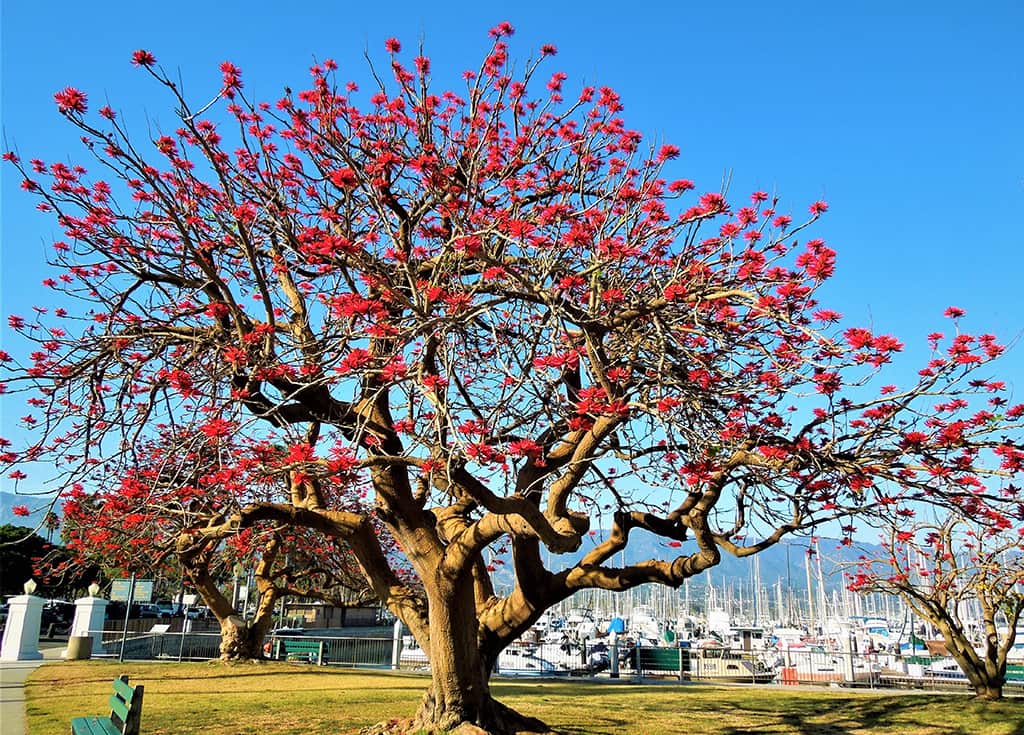Santa Barbara Beautiful Tree of the Month – April 2018

When in flower, the Naked Coral Tree looks more like a coral on a reef in the South Pacific than a tree on land in Santa Barbara!
Its buds appear in late winter, densely clustered at each bare branch tip. From February to May, the buds slowly develop into beautiful flowers – bearing brilliantly coral-red, sword-like, 3-inch long petals that radiate from the flower center. Hummingbirds just love the nectar. These exotic blooms are displayed on completely nude branches, well before the leaves return in the summer – hence the common name, “Naked”.
At the end of the flowering period, heart-shaped green leaves finally emerge, growing 3 to 5 inches long and almost as wide, and extending from the ends of 5-inch long petioles (leaf stems). When in full leaf, the rounded canopy provides dense shade.
This is a small- to medium-sized three, with a height and spread of 20 to 30 feet. It is usually low-branched or multiple-trunked, but with proper training can have a single trunk. The branching structure and the trunks are often contorted into interesting sculptural forms. Its bark is smooth and greenish- to pinkish-gray, with corky furrows. Fair warning: this other-wise lovely tree is well armed with short, sharp thorns – and its seeds are toxic.
The botanical name of the Naked Coral Tree is Erythrina coralloides. The genus name is from the Greek word erythros (meaning “red”); the specific epithet is coralloides (meaning “coral-like”) – certainly, both terms refer to the coral-red flowers. There is also a “Bicolor” form of Naked Coral Tree available – surprisingly, it has white flowers clusters, red flower clusters, and mixed red and white clusters – all on the same tree.
The Naked Coral Tree is native to eastern Mexico, at elevations of 2,500 to 8,500 feet. It is just one of eight different species of coral trees that have been planted in Santa Barbara over the years. Interestingly, though they are trees, all are in the same plant family as legumes or peas!
Coral trees do well here in our Mediterranean climate – and can be considered drought-tolerant, requiring only occasional deep watering after they are established. The Naked Coral Tree is the most cold-hardy and can sustain temperatures into the mid 20’s without damage, whereas the other species can experience frost damage below 32 degrees. All have relatively weak wood, so they do require regular pruning, in order to keep longer limbs from breaking off or large trunks from splitting apart, often rather dramatically.
Naked Coral Trees are street trees in the 1400 block of Shoreline Drive. Outstanding mature specimens can be see at the Santa Barbara Harbor, in Upper Orpet Park, in Franceschi Park, in Shoreline Park, at the roundabout at Santa Cruz Boulevard and Pacific (just north of Shoreline Drive), and on the UCSB Campus.
Tree-of-the-Month articles are sponsored by Santa Barbara Beautiful, whose many missions include the increase of public awareness and appreciation of Santa Barbara’s many outstanding trees and, in a long-time partnership with the City Parks & Recreation Department, the funding and planting of trees along the City’s streets – a project which has resulted in the planting, to date, of more than 13,000 street trees.
Article and photos by David Gress

